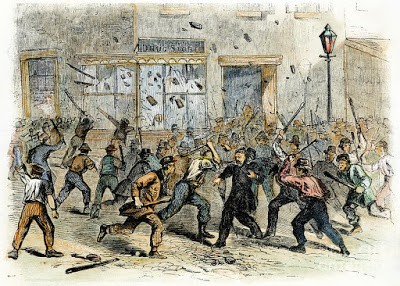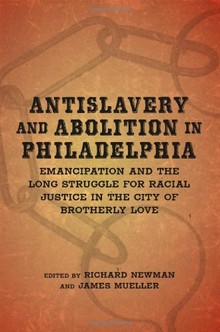Lombard Street Riot, 1842
Introduction
Text-to-speech Audio
On August 1, 1842, a white mob of mostly Irish immigrants attacked a parade of around 1,000 African Americans promoting temperance and commemorating the eighth anniversary of the end of slavery in the British Caribbean. The attack sparked a three-day riot during which members of the mob pursued marchers around the city, ransacked black homes in the area, and set an abolitionist meeting hall, several public buildings, and the Second African Presbyterian Church ablaze. The mayor called in 1,000 militia troops to finally put an end to the riot. Few rioters were arrested and those who were convicted received light sentences. The event was the third race riot that occurred within the previous decade (the other two took place in 1834 and 1838.
Images
A contemporary artist's rendition of racially-motivated attacks against abolitionists in Philadelphia that peaked in 1842.

Antislavery and Abolition in Philadelphia: Emancipation and the Long Struggle for Racial Justice in the City of Brotherly Love -Click the link below for more information about this book

This historical marker describes the riot and is located where the mob first attacked the marchers.
.jpg)
Backstory and Context
Text-to-speech Audio
Several factors contributed to the increasing racial tensions in Philadelphia during the 1830s and 1840s. The population surged from 161,410 to 388,721 as a result of rapid industrialization, which attracted people of different ethnic and religious backgrounds to the city including Irish immigrants and African Americans (the black population increased from 6,880 in 1800 to 15,625 in 1830). The city was ill-prepared to cope with this influx of new residents who settled in various municipalities outside of the original city limits. Competition for jobs between groups rose and black residents became increasingly vocal about their support of abolitionism. Other factors included the stripping away the right to vote for free blacks and the beginning of an economic depression in 1837 (called the Panic of 1837). It should also be noted that Irish immigrants faced discrimination from American Protestants for being Catholic.
Both Irish immigrants and African Americans were, in general, among the working class. However, the Irish (and other white residents) thought the black community was becoming middle class at their expense. Physical evidence for this perception were the African American churches and rising black population in the city. In short, the Irish and many others in the white community felt very economically insecure.
In the early 1830s, these tensions built up and exploded into a riot in August 1834. On the 11th, a group of whites and blacks got into heated argument about seats on a carousel, which was set up at Seventh and South Streets. However, rumors spread that the African Americans had insulted the whites and, as a result, the carousel was destroyed the next evening. That night, a white mob attacked the Moyamennsing neighborhood, where many African Americans lived, and ransacked homes and businesses. The riot continued for two more days. In the aftermath, two churches and over 30 homes were destroyed. Many residents were beaten as well. The constables tried to stop the violence but there were too few of them.
Racial tensions simmered during the next four years and flared again on May 15, 1838 during the opening of the large Pennsylvania Hall, which was newly built by local abolitionists as a meeting hall. The event began on the 14th without incident but a white mob gathered outside it on the 16th and broke the windows as activist Angelina Grimke was lecturing. The meeting ended but the next day a large mob set the building on fire and it burned to the ground. Fire fighters didn't try to stop the fire; they only protected nearby buildings. While sporadic fighting occurred over the next few years, the city was mostly peaceful despite the economic depression that began in 1837. This relative calm ended in 1842 with the Lombard Street Riot.
Cite This Entry
Trowbridge, David J. and Ben M.. "Lombard Street Riot, 1842." Clio: Your Guide to History. December 14, 2022. Accessed April 27, 2025. https://theclio.com/tour/59/2
Sources
Grubbs, Patrick. "Riots (1830s-1840s)." The Encyclopedia of Greater Philadelphia. 2015. https://philadelphiaencyclopedia.org/essays/riots-1830s-and-1840s.
Mandell, Melissa. "Lombard Street Riots Site." Historical Society of Pennsylvania. Accessed December 14, 2022. http://www.philaplace.org/story/62.
"Years of Growth and Challenge, 1830-1880." Preservation Alliance. Retrieved from the Web Archive on December 14, 2022. https://web.archive.org/web/20070627121121/http://www.preservationalliance.com/rise_sec3.php.
Wikimedia Commons: https://commons.wikimedia.org/wiki/File:Lombard_Street_Riot_Historical_Marker_at_6th_and_Lombard_Sts_Philadelphia_PA_(DSC_4614).jpg

